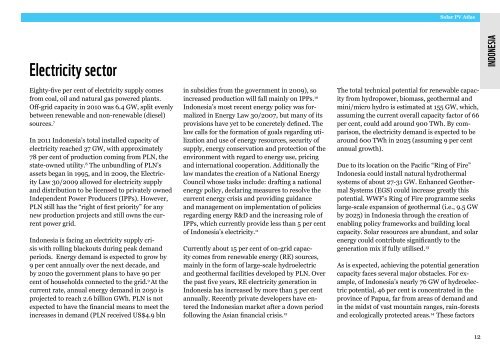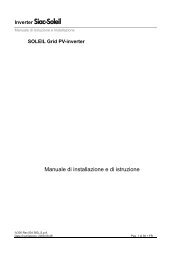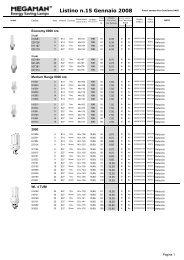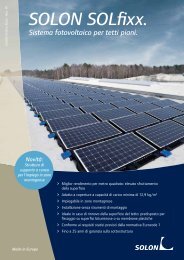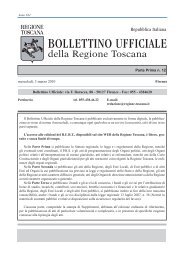Solar PV Atlas: Solar Power in Harmony with Nature - WWF
Solar PV Atlas: Solar Power in Harmony with Nature - WWF
Solar PV Atlas: Solar Power in Harmony with Nature - WWF
You also want an ePaper? Increase the reach of your titles
YUMPU automatically turns print PDFs into web optimized ePapers that Google loves.
<strong>Solar</strong> <strong>PV</strong> <strong>Atlas</strong><br />
Electricity sector<br />
Eighty-five per cent of electricity supply comes<br />
from coal, oil and natural gas powered plants.<br />
Off-grid capacity <strong>in</strong> 2010 was 6.4 GW, split evenly<br />
between renewable and non-renewable (diesel)<br />
sources. 7<br />
In 2011 Indonesia’s total <strong>in</strong>stalled capacity of<br />
electricity reached 37 GW, <strong>with</strong> approximately<br />
78 per cent of production com<strong>in</strong>g from PLN, the<br />
state-owned utility. 8 The unbundl<strong>in</strong>g of PLN’s<br />
assets began <strong>in</strong> 1995, and <strong>in</strong> 2009, the Electricity<br />
Law 30/2009 allowed for electricity supply<br />
and distribution to be licensed to privately owned<br />
Independent <strong>Power</strong> Producers (IPPs). However,<br />
PLN still has the “right of first priority” for any<br />
new production projects and still owns the current<br />
power grid.<br />
Indonesia is fac<strong>in</strong>g an electricity supply crisis<br />
<strong>with</strong> roll<strong>in</strong>g blackouts dur<strong>in</strong>g peak demand<br />
periods. Energy demand is expected to grow by<br />
9 per cent annually over the next decade, and<br />
by 2020 the government plans to have 90 per<br />
cent of households connected to the grid. 9 At the<br />
current rate, annual energy demand <strong>in</strong> 2050 is<br />
projected to reach 2.6 billion GWh. PLN is not<br />
expected to have the f<strong>in</strong>ancial means to meet the<br />
<strong>in</strong>creases <strong>in</strong> demand (PLN received US$4.9 bln<br />
<strong>in</strong> subsidies from the government <strong>in</strong> 2009), so<br />
<strong>in</strong>creased production will fall ma<strong>in</strong>ly on IPPs. 10<br />
Indonesia’s most recent energy policy was formalized<br />
<strong>in</strong> Energy Law 30/2007, but many of its<br />
provisions have yet to be concretely def<strong>in</strong>ed. The<br />
law calls for the formation of goals regard<strong>in</strong>g utilization<br />
and use of energy resources, security of<br />
supply, energy conservation and protection of the<br />
environment <strong>with</strong> regard to energy use, pric<strong>in</strong>g<br />
and <strong>in</strong>ternational cooperation. Additionally the<br />
law mandates the creation of a National Energy<br />
Council whose tasks <strong>in</strong>clude: draft<strong>in</strong>g a national<br />
energy policy, declar<strong>in</strong>g measures to resolve the<br />
current energy crisis and provid<strong>in</strong>g guidance<br />
and management on implementation of policies<br />
regard<strong>in</strong>g energy R&D and the <strong>in</strong>creas<strong>in</strong>g role of<br />
IPPs, which currently provide less than 5 per cent<br />
of Indonesia’s electricity. 11<br />
Currently about 15 per cent of on-grid capacity<br />
comes from renewable energy (RE) sources,<br />
ma<strong>in</strong>ly <strong>in</strong> the form of large-scale hydroelectric<br />
and geothermal facilities developed by PLN. Over<br />
the past five years, RE electricity generation <strong>in</strong><br />
Indonesia has <strong>in</strong>creased by more than 5 per cent<br />
annually. Recently private developers have entered<br />
the Indonesian market after a down period<br />
follow<strong>in</strong>g the Asian f<strong>in</strong>ancial crisis. 12<br />
The total technical potential for renewable capacity<br />
from hydropower, biomass, geothermal and<br />
m<strong>in</strong>i/micro hydro is estimated at 155 GW, which,<br />
assum<strong>in</strong>g the current overall capacity factor of 66<br />
per cent, could add around 900 TWh. By comparison,<br />
the electricity demand is expected to be<br />
around 600 TWh <strong>in</strong> 2025 (assum<strong>in</strong>g 9 per cent<br />
annual growth).<br />
Due to its location on the Pacific “R<strong>in</strong>g of Fire”<br />
Indonesia could <strong>in</strong>stall natural hydrothermal<br />
systems of about 27-31 GW. Enhanced Geothermal<br />
Systems (EGS) could <strong>in</strong>crease greatly this<br />
potential. <strong>WWF</strong>’s R<strong>in</strong>g of Fire programme seeks<br />
large-scale expansion of geothermal (i.e., 9.5 GW<br />
by 2025) <strong>in</strong> Indonesia through the creation of<br />
enabl<strong>in</strong>g policy frameworks and build<strong>in</strong>g local<br />
capacity. <strong>Solar</strong> resources are abundant, and solar<br />
energy could contribute significantly to the<br />
generation mix if fully utilised. 13<br />
As is expected, achiev<strong>in</strong>g the potential generation<br />
capacity faces several major obstacles. For example,<br />
of Indonesia’s nearly 76 GW of hydroelectric<br />
potential, 46 per cent is concentrated <strong>in</strong> the<br />
prov<strong>in</strong>ce of Papua, far from areas of demand and<br />
<strong>in</strong> the midst of vast mounta<strong>in</strong> ranges, ra<strong>in</strong>-forests<br />
and ecologically protected areas. 14 These factors<br />
INDONESIA<br />
12


